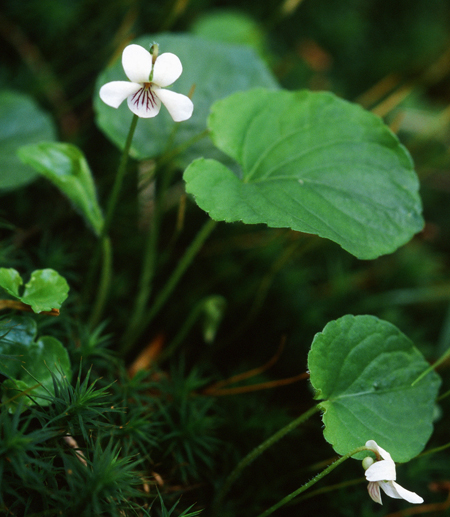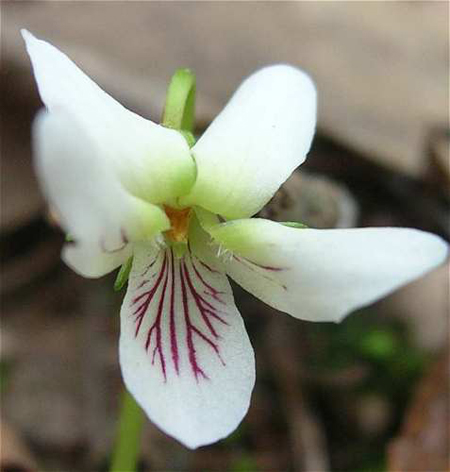Viola incognita Brainerd
Common names:
Common Sweet White Violet, Large-leaved White Violet
Synonyms:
Viola incognita Brainerd, Rhodora 7: 248. 1905. TYPE: USA, Vermont, Forest at base of Moosalamoo Mt., Salisbury, pubescent form [originally identified as Viola blanda], 5 May 1903, E. Brainerd s.n. (LECTOTYPE (designated by Ballard et al. 2020. Journal of the Botanical Research Institute of Texas 14(2): 222.): GH00067134!).
Viola incognita Brainerd var. forbesii Brainerd, Bull. Torrey Bot. Club 38: 8. 1911
Viola blanda Willd. var. palustriformis A.Gray, Bot. Gaz. 11: 255. 1886
Description:
Acaulescent stoloniferous perennials from slender rhizome, colonial from surficial stolons produced in summer, stolons naked or with 1 or more leaves along their length and terminating in a plantlet, ≤ 14 cm tall; foliage and peduncles gray-green, upper surface of leaf blades darker than lower, petioles and/or one or both surfaces glabrous or sparsely to moderately hirsute, peduncles often hirsute; stipules free, glandular-fimbriate; leaves ascending or spreading, leaf blades undivided, largest ≤ 61 × 72 mm, ovate to deltate-ovate or reniform, base shallowly and broadly cordate, basal lobes separated and mostly divergent in life, sinus > 1/4 (often > 1/3) length of blade, margins low-serrate, eciliate, apex usually obtuse to broadly rounded (occasionally broadly acute); chasmogamous peduncle held above the leaves; chasmogamous flower ≤ 13 mm long; calyx glabrous, eciliate; lowest sepals lanceolate to ovate-lanceolate, narrowly obtuse to rounded; auricles short and entire, not elongating in fruit; corolla white, throat greenish-white; spur short-globose; lateral petals bearded with slightly clavate hairs, spurred petal glabrous; chasmogamous capsule green; cleistogamous flowers produced after chasmogamous, on prostrate peduncle much shorter than petioles and arching upward just before capsule dehiscence; cleistogamous capsule 5–9 mm, green drying tan with purple spots or blotches, glabrous; seeds (1.6)1.9–2.2 × 1.0–1.3 mm long, light to medium brown, unspotted; 2n=44.
Similar species:
This species is most similar to other Stolonosae violets with leaf blades nearly as broad as to broader than long. In chasmogamous flower it differs from V. palustris and V. suecica in its non-creeping rhizome, leaves forming a discrete rosette, and white corolla; from V. blanda in its sometimes hirsute petioles and lower surface of leaf blades, and densely bearded lateral petals; from V. minuscula in its sometimes hirsute leaf laminas and noticeably serrate leaf blade margins, and from V. renifolia by its threadlike stolons, foliage often sparsely hirsute, leaves ascending, leaf blades commonly ovate to broadly ovate, and lateral petals densely bearded. It can be distinguished in cleistogamous fruit from V. minuscula, V. palustris and V. suecica by the rhizome and foliage characters noted above as well as its heavily purple spotted or blotched cleistgamous capsules and brown seeds; from V. blanda in producing summer stolons mostly lacking leaves and fruits along its length (but terminating in a plantlet), petioles and lower surface of leaf blades sometimes hirsute, leaf blades more broadly ovate to ovate-deltate with deeper broader basal sinus and obtuse apex, and seeds larger, more narrowly obovoid and lighter brown; and from V. renifolia by its horizontal stoloniform rhizomes and threadlike stolons, foliage often sparsely hirsute, ascending leaves, and leaf blades commonly ovate to broadly ovate.
Ecology:
Moist to wet somewhat acidic loamy, sandy or peaty soils in mesic to wet forests, at bases of slopes and swamp margins, rarely on rock ledges.
Distribution:
Northeastern North America, NL to SK, south to w. SC, e. TN, n IN, e. IA, ND. (no range map yet).
Rarity:
State listed in NJ, WV.
Phenology:
Chasmogamous flower April–June, chasmogamous fruit June, cleistogamous fruit June–September.
Affinities:
This species belongs to the Acaulescent White Violet lineage, sect. Plagiostigma Godron, subsect. Stolonosae (Kupffer.) Kupffer.
Hybrids:
Hybridizes with V. blanda (Russell 1954, 1955c, 1965), V. lanceolata (Ballard 1995), V. minuscula (Scoggan 1978, Ballard 1995), and V. renifolia (Ballard 1995). Hybrids with V. blanda might fail to reproduce by chasmogamous flowers, and cleistogamous capsules might express reduced viable seed output, while hybrids with the other species (being lower in ploidy) would definitely fail to reproduce chasmogamously and would produce either abortive cleistogamous capsules or no viable seeds. Studies are needed to confirm these predictions.
Comments:
Brainerd's protologue mentioned “Type in Hb. Gray from wooded slopes of Moosalamoo Mountain, Salisbury, Vermont, May 5, 1903, and August 14, 1905.” A specimen representing the cited May flowering collection has been located, but August fruiting specimens have not. Brainerd's second handwritten label states “Viola incognita, Brainerd, n. sp.,” indicating that the sheet was intended as a type. The GH sheet was designated by Ballard et al. as the lectotype.
Brainerd (1921b), Brainerd Baird (1942), Fernald (1950), Henry (1953a), Russell (1955c), Alexander (1963), Scoggan (1978), Strausbaugh and Core (1978), Swink and Wilhelm (1979), and Weakley et al. (2012) maintained this as a species separate from V. blanda. Gleason and Cronquist (1991), Ballard (1995, 2000), McKinney and Russell (2002), Voss and Reznicek (2012), and Little and McKinney (2015) synonymized it under V. blanda, while Haines et al. (2011) maintained it as V. blanda var. palustriformis A.Gray. Brainerd, Fernald, Henry, Alexander, Scoggan, and Swink and Wilhelm also recognized variety forbesii Brainerd, distinguished by pubescence confined to the upper surface of the leaf blades similar to the condition in V. blanda. Such plants, scattered over much of the western portion of the range of the present species, may at least partly explain reports of V. blanda in the western Great Lakes region. It has been synonymized under V. incognita by later taxonomists, or under V. blanda when only one species was recognized. Over much of its range, typical V. incognita varies from nearly glabrous or glabrate to quite hirsute on one or both leaf surfaces and petioles. Populations of V. blanda and the much rarer V. incognita in the Appalachian highlands express perplexing local variation, perhaps in part due to ongoing hybridization between V. blanda and V. incognita as suggested by Russell (1954, 1955c, 1965). This species and V. blanda are allo-octoploid derivatives of ancient hybridization between a V. minuscula-like ancestor of the Stolonosae lineage and V. renifolia (Marcussen et al. 2012, Blaxland et al. 2018). Allopolyploidy and long-term regional differentiation may partly explain the perplexing variation in the Appalachian region and also much of the morphological similarity and frequent confusion between V. incognita and V. renifolia, as well similarity in certain foliage features between V. blanda and V. minuscula and occasional confusion over identification. Within-population variation in certain features such as foliage indument and pigmentation (or lack of it) in either species, and relative leaf expansion, makes identification more challenging in chasmogamous material. The two species diverge most conspicuously in morphological characters during cleistogamous fruit; the seeds are then available to provide additional differences. Hybrids with V. renifolia are frequent in boreal North America and are commonly misidentified as V. renifolia when the stolons inherited from V. incognita and the infertile cleistogamous capsules are not noted.
Literature Cited:
Alexander, E. J. 1963. Violaceae. In Gleason, H. A., The new Britton and Brown illustrated flora of the northeastern United States and adjacent Canada. Hafner Publishing Co., Inc., New York, NY. 552-567.
Ballard Jr., H. E. 1995 ["1994"]. Violets of Michigan. Michigan Botanist 33: 131-199.
Ballard Jr., H. E. 2000. Violaceae. In Rhoads, A. (ed.). Flora of Pennsylvania. University of Pennsylvania Press, Philadelphia, PA. 700-710.
Ballard Jr., H. E., R. N. Burwell, and S. L. Lockhart. 2020. Violaceae: Typifications and clarifications of names. In Weakley, A. S., D. B. Poindexter, H. C. Medford, B. A. Sorrie, C. A. McCormick, E. L. Bridges, S. L. Orzell, K. A. Bradley, H. E. Ballard, Jr., R. N. Burwell, S. L. Lockhart, and A. R. Franck. Studies in the vascular flora of the southeastern United States. VI. Journal of the Botanical Research Institute of Texas 14(2): 217-229.
Blaxland, K., H. E. Ballard, and T. Marcussen. 2018. Viola pluviae sp. nov. (Violaceae), a member of subsect. Stolonosae in the Pacific Northwest region of North America. Nordic Journal of Botany 36.
Brainerd, E. 1921b. Violets of North America. Vermont Agricultural Experiment Station Bulletin 224: 1–172.
Brainerd Baird, V. 1942. Wild violets of North America. University of California Press, Berkeley, CA.
Fernald, M. L. 1950. Violaceae. In Gray’s Manual of Botany, 8th ed. American Book Company, New York, NY. 1022-1042.
Gleason, H. A., and A. Cronquist. 1991. Violaceae. In Manual of vascular plants of northeastern United States and adjacent Canada, 2nd ed. New York Botanical Garden, Bronx, NY. 157-163.
Haines, A., E. Farnsworth, and G. Morrison. 2011. Violaceae. In Flora Novae Angliae. Yale University Press, New Haven, CT. 873-886.
Henry, L. K. 1953a. The Violaceae in western Pennsylvania. Castanea 18(2): 37-59.
Little, R. J., and L. E. McKinney. 2015. Violaceae. In Flora of North America: Cucurbitaceae to Droseraceae, 106. Oxford University Press, New York, NY.
Marcussen, T., K. S. Jakobsen, J. Danihelka, H. E. Ballard, K. Blaxland, A. K. Brysting, and B. Oxelman. 2012. Inferring species networks from gene trees in high-polyploid North American and Hawaiian violets (Viola, Violaceae). Systematic Biology 60: 1-20.
McKinney, L. E., and N. H. Russell. 2002. Violaceae of the southeastern United States. Castanea 67: 369–379.
Russell, N. H. 1954. Three field studies of hybridization in the stemless white violets. American Journal of Botany 41: 679–686.
Russell, N. H. 1955c. The taxonomy of the acaulescent white violets. American Midland Naturalist 54: 481–494.
Russell, N. H. 1965. Violets (Viola) of the central and eastern United States: An introductory survey. Sida 2: 1-113
Scoggan, H. J. 1978. Violaceae. In Flora of Canada, Part 3–Dicotyledoneae (Saururaceae to Violaceae). National Museums of Canada. Ottawa, Canada. 1103-1115.
Strausbaugh, P. D., and E. L. Core. 1978. Violaceae. In Flora of West Virginia, 2nd ed. Seneca Books, Inc., Morgantown, WV. 644-658.
Swink, F., and G. Wilhelm. 1979. Violaceae. In Plants of the Chicago region, 2nd ed. revised and expanded. Morton Arboretum, Lisle, IL. 384, 801-810.
Voss, E. G., and A. A. Reznicek. 2012. Violaceae. In Field manual of Michigan flora. The University of Michigan Press, Ann Arbor, MI. 913-922.
Weakley, A. S., J. C. Ludwig, and J. F. Townsend. 2012. Violaceae. In Flora of Virginia. BRIT Press, Fort Worth, TX. 963-975.

Chasmogamous flowering habit by Merel Black, the "Online Virtual Flora of Wisconsin" website under Creative Commons license BY-SA 3.0

Chasmogamous flowering habit by Kim Blaxland, "Botanikim" website (permission granted by Chris Blaxland)

Chasmogamous flower front view by Merel Black, the "Online Virtual Flora of Wisconsin" website under Creative Commons license BY-SA 3.0

Chasmogamous flower front view by Kim Blaxland, "Botanikim" website (permission granted by Chris Blaxland)